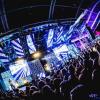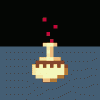I think these rat experiments are relevant to the question:
Study Abstract:
γ-Hydroxybutyric acid (GHB), an endogenous organic acid catabolite of γ-aminobutyric acid (GABA), has been shown to have tissue-protective effects in various organs, including the brain. We examined the potential neuroprotective effect of GHB and its chemical precursors, γ-butyrolactone (GBL) and 1,4-butanediol (1,4-BD), in the rodent ischemic stroke model by intraluminal filament middle cerebral artery occlusion (MCAO). Adult male Sprague-Dawley rats underwent transient left-sided MCAO and received intraperitoneal treatment with 300 mg/kg of GHB, GBL, 1,4-BD, or control vehicle given at 30 min before, as well as 180 and 360 min after the onset of ischemia. Infarct volumes were determined 24 h after MCAO. In transient MCAO, the mean volume of infarction for control rats was 464.4 ± 17.9 cu.mm versus 273.6 ± 53.1, 233.3 ± 44.7, and 275.4 ± 39.9 cu.mm for rats treated with 1,4-BD (P < 0.05), GBL (P < 0.05), and GHB (P < 0.05), respectively.
We conclude that GHB, GBL, and 1,4-BD protect against rat focal cerebral ischemia from transient MCAO. StudyAbstract
γ-Hydroxybutyrate (GHB) and its lactone, γ-butyrolactone (GBL) have been previously shown to produce a protective effect in animal models of cerebral ischaemia/hypoxia, as well as in human conditions of head injury-induced coma. The aim of the present research was to study the effect of GHB in experimental conditions of focal cerebral damage, either induced by ischaemia or excitotoxicity. Under general anaesthesia, rats were injected into the right striatum with either endothelin-1 (ET-1, 0.43 nmol) or kainic acid (7.5 nmol) in a volume of 1 μl. Sham-lesioned rats received 1 μl of the solvent. Both ET-1- and kainic acid-lesioned rats were randomly assigned to one of the following intraperitoneal (i.p.) treatments: (i) and (ii) GHB, 100 or 300 mg kg−1 2 h after the lesion, followed by 50 or 100 mg kg−1, respectively, every 12 h; (iii) saline, 2 ml kg−1, same schedule. Sham animals were treated with saline, 2 ml kg−1, same schedule. Treatments lasted for 10 days. The higher dose of GHB produced a significant protection against the ET-1-induced impairments in sensory-motor orientation and coordinated limb use (evaluated 24 and 42 days after the lesion) and in place learning and memory (Morris test, performed 19 and 39 days after the lesion). The same dose regimen reduced the circling behaviour induced by apomorphine in kainate-lesioned rats (10 days after the lesion), and limited or prevented at all the histological damage produced either by ET-1 or by kainic acid (evaluated 43 or 10 days after the lesion, respectively).
These results show that GHB limits both histological and functional consequences of a focal ischaemic or excitotoxic insult of the brain, in rats, even if the treatment is started 2 h after the lesion.On the other side:
Gammahydroxybutyric acid (GHB) is an endogenous constituent of the central nervous system that has acquired great social relevance for its use as a recreational 'club drug'. GHB, popularly known as 'liquid ecstasy', is addictive when used continuously. Although the symptoms associated with acute intoxication are well known, the effects of prolonged use remain uncertain. We examined in male rats the effect of repeated administration of GHB (10 and 100 mg/kg) on various parameters: neurological damage, working memory and spatial memory, using neurological tests, the Morris water maze and the hole-board test. The results showed that repeated administration of GHB, especially at doses of 10 mg/kg, causes neurological damage, affecting the 'grasping' reflex, as well as alteration in spatial and working memories. Stereological quantification showed that this drug produces a drastic neuronal loss in the CA1 hippocampal region and in the prefrontal cortex, two areas clearly involved in cognitive and neurological functions. No effects were noted after quantification in the periaqueductal grey matter (PAG), a region lacking GHB receptors. Moreover, NCS-382, a putative antagonist of GHB receptor, prevented both neurological damage and working- memory impairment induced by GHB. This suggests that the effects of administration of this compound may be mediated, at least partly, by specific receptors in the nervous system. The results show for the first time that the repeated administration of GHB, especially at very low doses, produces neurotoxic effects.
This is very relevant because its abuse, especially by young persons, could produce considerable neurological alterations after prolonged abuse.On the other hand, from
http://www.ceri.com/q_v7n4q1.htmIn a long-term dosing experiment in rodents, very high doses of butyrolactone showed a surprising lack of toxicity [NTIS, 1992]. The researchers gave 0, 112 and 225 mg/kg GBL to male rats; 0, 225 and 450 mg/kg GBL to female rats; and 0, 262 and 526 mg/kg GBL to both male and female mice. Scaled to human body size, these rodent dosages are about ten times what humans would use. The GBL was administered 5 days per week by gavage (stomach tube).
At the end of 2 years (old age, for rats), the survival of male rats was 48% for the control group, 54% for the intermediate-dose group and 64% for the high-dose group. That’s right, the GBL-treated male rats lived longer! This was attributed to a decreased incidence of mononuclear leukemia. In the female rats receiving double the dose of the male rats, the survival was not significantly different between the three groups: 56%, 54% and 54% respectively. However, the body weight of the GBL-dosed females was 10-20% lower than that of the controls.
Maybe the rats were dumb and lived longer?¿
Personally I use GBL for sleep from 1 week ago ( I suffer from Idiopathic Hypersomnia not yet treated) and I haven't converted it to GHB yet. I think I am better than before in the cognitive part, but this can be attributed to proper sleeping.
Judge for yourselves, there are a lot more studies on rats on the web.
Have a nice day.
Edited by frchopin, 15 October 2009 - 05:25 AM.
Actually, GHB is one of my fav's when it comes to the effects. But that is not making me blind and start calling it "liquid gold" and nonaddictive just because it like it. Another problem is correct dosing, since it affects you like benzo and alcohol, your judgement is not exactly 100 % when you are on it. I've seen soo much.. Hypersmart and successful people that have used it for years, but still pass out in public, etc etc..

















































